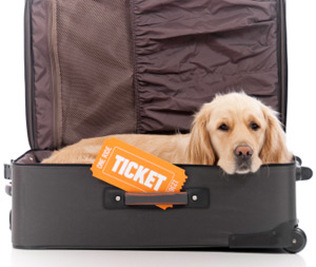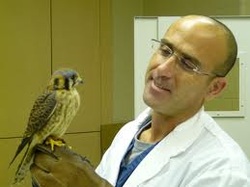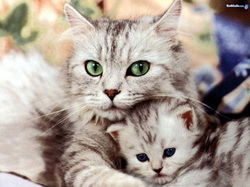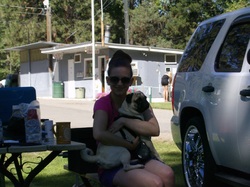Before I get to my main article I first want to share some TREATS with YOU! You always give your pets treats now here is some for yourself: these important things I discovered this morning while doing some research could help you! First of all, please check out How to become a Pet-Sitter! Some very informative and AWESOME info on how to start your own business becoming a Pet-Sitter! Now, if you have to go away on holiday WHO do you trust to take care of your animals? I found this AMAZING Pet-Sitter directory that matches you up to the perfect pet-sitter for YOU! Just Click Here for access to the directory info. Now onto the main attraction ...  Planning a road trip with Rover? Even the most enthusiastic traveler can become agitated and anxious on a very long ride. Here are some suggestions for making car travel safe and pleasant for you and your dog:
* Watch the
temperature. Even with the air conditioning on, a dog riding in the back of a van can become overheated from direct sunlight shining into the vehicle. Sun
shades will reflect heat and keep your traveling companion cool. And small battery-operated fans attached to the dog's crate will keep the air moving.
* Remember to never leave your dog in a closed car. It can take just minutes for the temperature to rise enough to kill an animal.
* Help your
dog relax. If your dog becomes anxious, a calming product, like Pluto Pet's Pet Calming Spray (or just give his favorite treats and bring his favorite blanket and toy!), may help relieve his fear, nervousness and aggression. Made from natural ingredients, the spray acts quickly, causes no side effects and meets all Food and Drug Administration guidelines for good manufacturing practices.
*Avoid tranquilizers, which can lower the animal's blood pressure and make the dog more prone to heat-related medical emergencies.
* Keep the
dog contained. Your travel companion should either be in a crate or restrained by a seatbelt made especially for animals. Dogs riding unrestrained in a car can be dangerous to themselves, the humans riding with them and other motorists.
* Make two tags: one with your home address and another with the destination address in case the dog gets lost while on the road. You should also have your dog's rabies tag and certificate and medical records.
* Pack a doggie bag. Your dog will appreciate some familiar things from home - a favorite blanket, for instance, and some toys. Bringing drinking water and food from home will help avoid stomach upset. And don't forget the cleanup supplies, because accidents happen.
* If your dog is territorial and you spend a night in a motel, keep the curtains drawn so the dog won't feel the need to protect his new turf from everyone who walks by your windows.
* Have fun! A trip together can be a wonderful bonding experience for you and your dog.
 A small to medium sized dog, the beagle weighs between 20-28 lbs and is 12" to 16" in height. Sometimes referred to as the English Beagle, this breed is energetic, friendly and loyal both as a family companion and hunting dog.
Coat colors accepted by the AKC are orange and white, lemon and
white, red and white or tri-colored. Black, white and tan tri-colored coats are the most common. Their medium length coat is smooth, hard and close. It requires minimal brushing and only needs washing occasionally.
Friendly, loyal, loving and playful are all qualities that make them excellent family pets. Homes
with other dogs, pets and children can all welcome the Beagle as part of the
family. They require minimal socialization and actually enjoy the companionship
of other pets and their family. A very energetic breed, the beagle needs a home
that will give them plenty of play time, exercise and regular walks. When
outside they should be in a fenced in yard and a leash should be used for walks
as they have a tendency to explore and follow scents. They make good watchdogs
as they will let you know if someone is at the door by barking, but they are
naturally friendly with strangers, so don't expect them to be good guard dogs.
Originating in England, this scent hound was bred for hunting rabbits
and quails. They would often hunt in packs or pairs, but can also hunt well
alone as well. They have an excellent sense of smell which makes them good at
tracking and as narcotics dogs. Today they are mainly seen as companion dogs in
the United States, but they are also used as hunting dogs.
A breed with such a friendly, loving nature is perfect for just about any family dynamic.
Because of their high energy level and need for regular exercise, they work best
with active families or those that have a yard where they can have plenty of
time to roam and run. If you are looking for an affectionate breed that enjoys
family companionship and loves to play, then the Beagle is the perfect dog for
you.
 (( Side note: Check out the new Photos page!! ))
One of the most crucial and important of decisions a pet-parent makes it that of choosing a great vet. It is the vet who will understand your pet when he/she gets ill and care enough to practice what is now popular as preventive health care.
Never choose a vet because he/she has a nice smile or a beautiful office or is cheap or the closest (although the closest vet to you COULD be the best vet ever, who knows?). Choose a vet who thinks about your pet the same as you do and always keeps the best interest of the pet ahead of all other considerations. The vet must love all types of animals and must:
- Be kind and gentle when handling the animal. He/She must not leave diagnosis or check ups to assistants.
- Have posted certification to practice veterinary care. In Canada they might have a certificate from University of Saskatchewan Western College of Veterinary Medicine and the University of Prince Edward Island, or Atlantic Veterinary College.
- He/She must always stay ahead of developments in medicine and update his skills and knowledge
constantly. (Look for certificates hanging around the office for the doctor or their staff attending recent workshops or courses pertaining to continuos veterinary training. My awesome vet and her assistants have different papers hanging about the office showing their completion of different training courses they go to on their own time to continue their knowledge in animal care.)
- The vet must be able to stand by you through thick and thin and give timely advice.
- The clinic must be very clean and have space for overnight stay with clean kennels, space to run, and staff and sometimes volunteers who love animals.
- It is ideal if the clinic offers health care plans for your pet.
- Ask the clinic if they have emergency contact numbers so that you can call if an unforeseen problem occurs in the middle of the night or on a public holiday.
- Check if the clinic has specialists consulting with them like orthopedic doctors and eye specialists.
As a concerned pet parent you must make a list of questions you need answers to. Spend a little time on researching online opinions on the vet as well, but an in person visit or meet and greet is the best. .
It is essential for you to choose a vet who will work along your side in caring for the pet. He/she must be patient, love the animal, and make time to explain things to you as well as take your opinion of things. After all, no one can know your pet better than you. He/she must be organized and maintain health records in great detail from the day the pet is brought in for the first visit to the day it passes away.
A pet will lead a complete existence only if you, the vet, and trainer work in harmony and side by
side. So, choosing a suitable vet is an important decision that must be done after weighing all the pros and cons.
 Ferrets can sometimes be thought of as a rare
pet to own. Most individuals choose dogs, cats, birds, or fish to complete their family, however some want the ferret for its social, playful, curious qualities! Ferrets love to play and explore not only with others and their owners, but also on their own. (In PAIRS of course. They will be lonely if they don't have a ferret buddy.) For this reason, you need to know a few things about how to take care of a ferret.
First, you will want to ferret proof your home before you introduce them as pets. They will crawl into walls, furniture, and anywhere they can get their little bodies. It is much like childproofing a
home for a baby. You will want to make sure all of the dangers are eliminated when you allow them out of their cages for playtime.
Ferrets are also biters. The kits, baby ferrets, tend to bite more. You can eliminate the problem
or tone it down with frequent handling. It is a sign of their behavior as mock fighting or sparring. The younger ferrets tend to bite more when they are teething and do not mean any harm. For this reason, you will want to handle the ferrets as often as possible to help reduce the biting behavior. Often
those who do not take the time or patience to train their ferret end up leaving
the animal in its cage and thus it has a shorter lifespan. Please make sure you
are up to the task of training a ferret before brining one into your home.
Trained properly they can be as great a pet (or better) as cats or dogs.
A ferret's lifespan is usually six to ten years, however proper care and feeding can lead
to a little longer life. Ferrets are carnivores so they require a high protein
diet. You can buy great ferret food in pet stores. Carefully reading the label will tell you if
it has the proper high protein diet. Please make sure you are buying a high quality brand of ferret food .
While play is an important part of your ferret's life, so is sleep. Most ferrets spend
fourteen to eighteen hours a day sleeping. Part of sleeping is to rejuvenate
them from the active play life they have. They love to explore and to play with
toys. Many pet stores have toys for ferrets, or you might have something around
the house that your ferret will find appealing.
The type of cage is important. FERRET NATION or CRITTER NATION cages are the best. (I use the critter nation one for my Rats) Ferrets tend to be very smart so you will need a cage where they can get
plenty of air, but small enough bars they cannot slip through. You will also want
to clean the cage once or twice a week depending upon the number of ferrets you
have, and how dirty the cage looks. Join a ferret related online forum for extra help and tips about this. They are also burrowers so some type of bedding is required. Carefresh animal bedding or large towels would work.
Ferrets are little balls of fur that love to play and interact with humans and each other. While there are some special concessions you need to make to have a ferret the results are worth it. Proper training as a youngster will give you even more joy when they reach adulthood.
Have a nice day and please donate to help me support my own Vet Bills! I have to keep my babies healthy too.
 Today's topic is Cats: Introducing a New Kitty to Your Crew!
When you decide to add a new cat to your home, it's normally more exciting for you and your family than it is for the cat you already own. Although most cats are
solitary by nature, most will also come to accept or eventually tolerate any
additions. Cats can be very territorial, which is why you should always be
careful when you introduce a new cat to your current cat.
If you are introducing kittens to one another, the entire introduction process can
be short, lasting as little as 10 - 15 days. Introducing cats to each other all depends on their temperament and their personality. When you introduce a new cat to your current cat, you should always make sure that you give your current cat plenty of love and attention. This way, your cat will feel secure and know that he isn't in competition with your new cat for affection.
When you bring your new cat home, you should let him stay in a safe room until you
have finished introducing the cats. Your safe room can be any small room in your
home, such as a bathroom or spare bedroom. The key here is to use a room that
your current cat doesn't go in. In the room, you should leave your new cat a
scratching post, bed, water dish, litter box, and food dish filled with crunchies.
At first, your current cat may howl and hiss when he stands at the door, trying to
tell the other cat that he doesn't belong. When this happens you should ignore
it, as punishing your cat for his behavior will only lead to more problems.
After a while, the first cat will start to act calm when he is near the new
cat's door. As he starts to act calm, you should pet him and give him
praise.
When your first cat starts to go by your new cat's door and doesn't howl or hiss; you
can start introducing them to each other. The best way to do this is to get them
used to each others scent. You can start letting them eat out of the same food
dish, although you'll want to feed them at different intervals at first. This
way, the scent of each cat will be present at the food dish, and each cat will
get the scent when he eats his food.
Once both cats have got used to the scent, you can begin to feed them closer
together. To do this, you should keep your new cat in the safe room with the
door closed, and your first cat on the other side of the door with his food
dish. This time, feed both cats at the same time. After doing this a few times,
they should start eating without any hissing or growling. At this point, they
are ready to be introduced to one another.
When you introduce them to each other in the same room, a bit of growling and hissing
is to be expected. Although they may be used to each others scent; your first
cat will still feel a bit awkward with your new cat being in his territory. You
should play with them both at first, so they can smell one another and greet in
their own way. If they start to fight you should break them up, (Be careful! Perhaps wearing a good sturdy pair of gardening gloves would be a good idea just in case!) and give them some time apart.
It may take some time to get them fully used to one another, although once they do
- they will become playmates for life. Cats love to be social, although it may
be a bit rough at first, especially for your first cat. Cats can be very
territorial, especially if you have a kitten around. If you get both of them
used to each other early on it will be a lot easier to add future cats to your
home.
 Welcome to Pet Health Care Tips! My name is Nikki and I love animals!
Every day or so I will post some VERY useful
articles related to general pet health care. Some days will feature
cats, some days will feature rats! Some postings will
feature ferrets, dogs, birds, and everything else in between!
I aim to post information on as many different types of pets as possible.
What I need now is YOU! I want to know what YOU want to know regarding Pet Health Care!
What TIPS do you want to hear about Pet Health Care?
I look forward to hearing from you!
|










 RSS Feed
RSS Feed